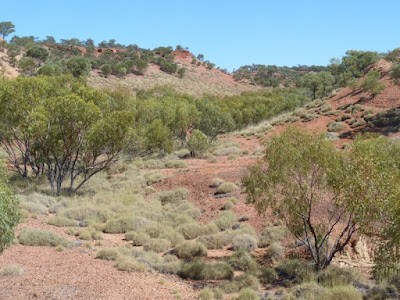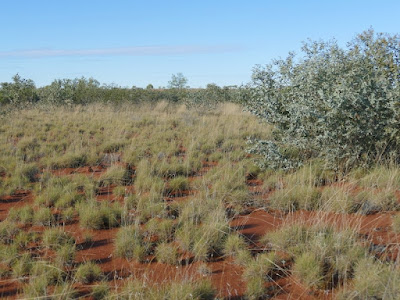This is a topic close to my heart. I grew up in South Australia, and Adelaide is nearer to
remaining mallee than any other state capital (with the possible exception of Melbourne).
Dad loved it, and I spent time in the mallee long before I encountered any real forests,
let alone wet ones. It seems strange then that it has taken me this long to tackle it
here, but maybe I've never felt ready to do it justice. Such excuses however can lead to us
to never doing anything worthwhile so, prompted by a recent camping trip to
north-western Victoria, here's my tribute to a uniquely Australian habitat.
"No-one knows who made the mallee, but the devil is strongly suspected", at least according to an anonymous writer in The Bulletin in 1901.
 |
| Mallee to the horizon from Warepil Lookout in Hattah-Kulkyne National Park, north-western Victoria. |
The Bulletin disparager came from a long line of whitefella mallee-bashers. Surveyor-General John Oxley (admittedly pretty much always a glass-three-quarters-empty character, judging by his journals), wrote of the mallee country along the Cocoparra Range in south-western NSW in 1817 as "country of the most miserable description... abandoned by every living creature capable of getting out of there". (The local people were understandably uninterested in making his acquaintance.) Others wrote similarly. Later reports however revealed the real reason for the general antipathy. Charles Sturt in 1833, the first to enter the vast South Australian-Victoria mallee lands, of which Hattah-Kulkyne above is but a remnant, described it as "barren and unproductive as the worst of the country we have passed through". An 1851 report to the Victorian Government Surveyor reported that "throughout the whole of the scrub there is neither stone nor timber fit for any useful purpose". The crime of this lovely, subtle and uniquely Australian landscape was that it wasn't apparently 'useful', so there was no point to it.
 |
| Sandhill Wattle Acacia ligulata flowering in mallee in Wyperfeld NP, north-western Victoria. |
Nor was this attitude limited to the 19th century by any means. The term 'desert' was applied to the spectacularly rich and highly floral mallee heath country of eastern South Australia and western Victoria - the Ninety Mile Desert in SA, Big and Little Deserts in Victoria. Now, I love the desert lands, but there was no affection in these labels. They couldn't grow wheat or wool, so were effectively sterile.
But there were mallee farmers, and they were tough. Low rainfall, low soil nutrients (ie by European farming standards) and the incredible resilience of the mallee eucalypts, which resprouted from massive underground lignotubers (of which more in a moment) immediately after clearing, made the farmers' lives hell. Moreover the lignotubers ('mallee roots') simply broke their ploughs. In time though ingenuity, technology and science proved too much for even the ancient mallee habitats. Mulleinising in the 1870s meant clearing the bush by dragging water tanks on chains between horses (later tractors), then burning, rough planting and again burning the stubble to knock the regrowth back again. Taller wheat strains just kept their heads above the regenerating scrub. About this time too a Mr Smith of Maitland on South Australia's Yorke Peninsula invented the 'stump jump plough' so that it wasn't necessary to grub out all of the stumps. The invention of superphosphate at Roseworthy College north of Adelaide in the 1880s allowed continuous cropping to assist in controlling regeneration. After this over a million hectares of mallee in the higher rainfall, sandy loam soils north of Adelaide, on the Yorke Peninsula (where almost no original vegetation now remains) and in Western Victoria, were rapidly cleared.
Millions of hectares more followed in the periods after both world wars, in western NSW, the far north-west of Victoria, Eyre Peninsula and out towards the Nullarbor, and in the south-west of WA. The pace slowed though as erosion issues and soil degradation followed, though the discovery of the role played by missing trace elements (especially cobalt and copper) triggered another burst in the 1950s and 60s. Ironically the Ninety Mile Desert was now redubbed Coonalpyn Downs... It wasn't until the 1970s that mallee conservation became something to consider.
So, perhaps belatedly on my part, what is 'the mallee'?
 |
| This map (courtesy of the Australian National Botanic Gardens) gives an indication of the current (green) and estimated former (pink) distribution of mallee woodlands, mostly in the semi-arid 200 - 550mm rainfall zone. However we should note that the current range by no means implies continuous or undamaged mallee. Most is fragmentary, and what remains doesn't reflect the original diversity of the different mallee habitats. |
 |
| Mallee form, Mungo National Park, western NSW. |
 |
| The top of a large lignotuber protruding from the ground, with the branches growing up from it. Hattah-Kulkyne National Park. |
 |
| Gum-barked Coolabah (though it has several names across its broad inland distribution) E. intertexta, near Cobar, western NSW. |
 |
| The same species growing as a mallee at Redbank Gorge, western Tjoritja (MacDonnell Ranges) National Park. |
 |
| Port Jackson Mallee E. obstans, Currarong, north end of Jervis Bay, south coast NSW. This mallee grows in sand and sandstone along the coast from here to Sydney. |
 |
| Blue Mountains Mallee Ash E. stricta, Blackheath, Blue Mountains, NSW. This one too, well out of the mallee zone, grows on shallow sandy soils on ridges. |
Mallee-Heath, as the name suggests, has an understorey of heathy shrubs (banksias, hakeas, grevilleas, casuarinas and callitris for example) and grows in deep sand in higher rainfall areas of the zone. For this reason it was one of the first regions of the mallee zone to be cleared for agriculture. Here are a couple of surviving examples.
 |
| Sand Stringybark E. arenacea, Little Desert NP, north-western Victoria. (This species was, until 1988, included with the more widespread Brown Stringybark, E. baxteri.) |
 |
| Mallee with a sparse heathy understorey (with also some saltbush I think), Gawler Rangers NP, north of the Eyre Peninsula, South Australia. |
 |
| Regenerating burnt mallee, Gluepot Reserve, north of the River Murray in South Australia. (Actually this was not at all the fiercest mallee fire, as the dead stems are still standing, though most other plants have gone.) |
 |
| Normanton Box Eucalyptus normantonensis growing as a mallee form over spinifex by the excellent dinosaur museum at Lark Quarry, central Queensland. |
 |
| Mallee with a dense spinifex ground cover, Mungo National Park, south-western NSW. |
 |
| Thick-leaved Mallee E. pachyphylla growing in a sandy spinifex plain, Great Sandy Desert, central eastern Western Australia. |
 |
| Huge (ie long unburnt) spinifex hummock in mallee, Wyperfeld NP, north-western Victoria. |
 |
| Mallee with a bluebush (Maireana spp.) understorey, Red Banks Conservation Park, mid-north South Australia. |
 |
| Late afternoon over mallee-bluebush at Caiguna, west of the Nullarbor Plain in south-eastern Western Australia. |
 |
| Samphire (probably Tecticornia spp.) growing on a clay pan in mallee-bluebush near Normantion, central southern Western Australia. |
 |
| Bushy Yate E. lehmanii, Cape Le Grande NP, in the east of south-western WA. A spectacular mallee from Albany eastwards as far as Israelite Bay in hill country and dunes. |
 |
| Mottlecah E. macrocarpa (above and below), Yandin Hill Lookout, north of Perth, WA. Its flowers are possibly the most dramatic of all eucalypt flowers, and can be up to 10cm across. |
 |
| Thick-leaved Mallee E. pachyphylla, here deep in the Great Sandy Desert of central eastern WA though it is found widely in central Australia. |
 |
| Moort E. platypus, Ravensthorpe, south-west WA. The name means 'flat or broad foot', for the oddly shaped buds. It grows only along this section of coastline. |
 |
| Bell-fruit Mallee E. preissiana, Stirling Ranges, south-west WA. |
Should you wish to be added to it, just send me an email at calochilus51@internode.on.net. You can ask to be removed from the list at any time,or could simply mark an email as Spam, so you won't see future ones.
If you do leave a comment - and I love it when you do - please remember to click the
box below your comment that says 'Email follow-up comments to...[your address]'
so you'll know when I reply - and I always do!









8 comments:
Thanks so much Ian for taking me on a journey through those mallee areas, I have many wonderful memories of bush camps in most ot them. Will be recommending to some of my friends to join you email list if I may
Thanks Graham, and good to hear from you. I'm always pleased to read that someone has enjoyed a blog post. And yes, please do suggest that people contact me to receive notifications of new postings, I always welcome new readers, of course!
Are you not being a tad generous with the rainfall estimate? Surely most of the SA Mallee at least is East or North of Goyder's Line, so should be <25mm of rain per year. Whenever I think of farming in this area I recall comments in the early 1970s by a wheat-sheep farmer, somewhere between Loxton and Karoonda, along the lines of 1 year in 10 get a very profitable crop, 4 years get a saleable crop, 2 years get 'seed and feed' 2 years get back what you sowed and 1 year don't bother putting the header in the paddock.
Yes Ian, your post did bring back happy mallee memories. Thank you!
Not my estimates Martin; to be honest I can't remember my source now, but it was a scientific article that I trusted at the time (for a talk I gave at the Bot Gardens very long ago). I think the issue is that it describes the original mallee limits, but the higher rainfall areas were pretty much completely cleared long ago, leaving the less desirable (ie lower rainfall) areas that were encroached on much later and less comprehensively.
My pleasure Marita, it was fun to write and I'm already enjoying selecting photos for the post(s) on mallee plants and animals.
I grew up in Keith SA - so I have many wonderful memories of the 90 mile desert/plain etc. Dad was one who cleared the Yorke Peninsular and did a lot of clearing around Keith using big Caterpillar tractors and ships anchor chain slung between them. the in later life planted thousands of trees. The biodiversity of the mallee always astounded me. Thanks for the memories
Hello David, and my grateful thanks for taking the trouble to comment. I wonder how you came across the post? I did my Honours thesis on 'islands' of mallee in cleared land near Keith (mid-70s!), and dad worked with CSIRO on the copper-cobalt deficiency problem for sheep, down there and on Kangaroo Island. It's a wonderful system though, isn't it, when left to its own devices? I'm glad I've brought back good memories for you, that alone makes the work worthwhile. I hope you find these comments, and I hope that you will also enjoy the coming posts on some plants and animals of the mallee. cheers, Ian
Post a Comment